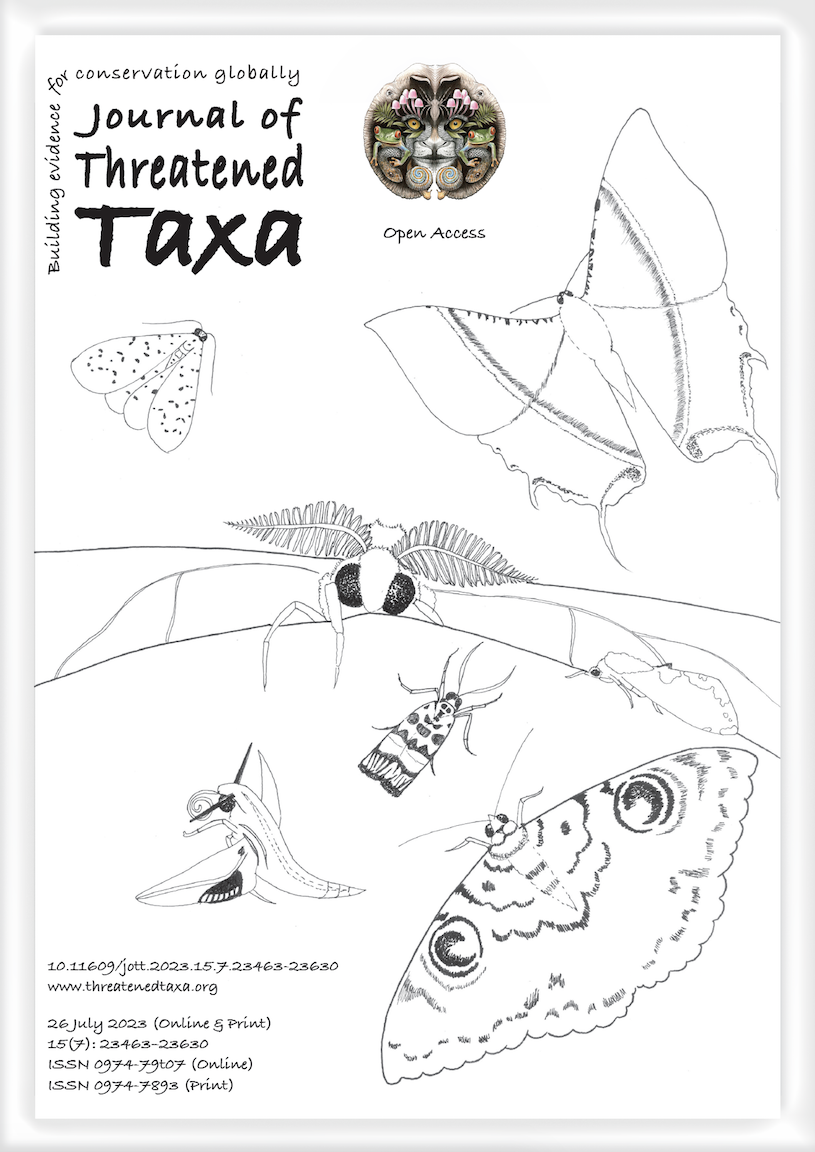Population status of Oriental Darter Anhinga melanogaster Pennant, 1769 (Aves: Suliformes: Anhingidae) in Keoladeo National Park, India
Main Article Content
Abstract
Oriental Darter Anhinga melanogaster belonging to the family Anhingidae is a globally ‘Near Threatened’ species occurring in southern and southeastern Asia. The Keoladeo National Park (KNP), Bharatpur, Rajasthan is also known to harbour some population of this species where this study was carried out to assess the population status. Eight wetland blocks were surveyed in different seasons from January 2021 to December 2021 in KNP. The average population of Oriental Darter was found to be maximum (112.8 ±43.8 SE, n = 8) in the winter season, whereas the least (1.8±1.1 SE, n = 8) in the summer season. The maximum population size of darters among the eight wetland blocks was witnessed in Block D of KNP harbouring a mean population of 84.3±20.2 SE (n = 12), whereas the minimum population occurred in Block F (0.3±0.16 SE, n = 12). However, seasonally the total number of darters recorded in all eight wetland blocks during winter, summer and monsoon was 287, 83, and 212, respectively. The findings of the current study reveal that the KNP sustains a viable resident population of Oriental Darters. Further studies are therefore recommended for understanding the seasonal movement pattern and other ecological aspects for its long-term conservation planning.
Article Details

This work is licensed under a Creative Commons Attribution 4.0 International License.
Authors own the copyright to the articles published in JoTT. This is indicated explicitly in each publication. The authors grant permission to the publisher Wildlife Information Liaison Development (WILD) Society to publish the article in the Journal of Threatened Taxa. The authors recognize WILD as the original publisher, and to sell hard copies of the Journal and article to any buyer. JoTT is registered under the Creative Commons Attribution 4.0 International License (CC BY), which allows authors to retain copyright ownership. Under this license the authors allow anyone to download, cite, use the data, modify, reprint, copy and distribute provided the authors and source of publication are credited through appropriate citations (e.g., Son et al. (2016). Bats (Mammalia: Chiroptera) of the southeastern Truong Son Mountains, Quang Ngai Province, Vietnam. Journal of Threatened Taxa 8(7): 8953–8969. https://doi.org/10.11609/jott.2785.8.7.8953-8969). Users of the data do not require specific permission from the authors or the publisher.
References
Ali, S. & S.D. Ripley (1987). Handbook of the birds of India and Pakistan, Compact Edition. Oxford University Press, New Delhi, 737 pp.
Bibby, C.J., N.D. Burgess, D.A. Hill & S.H. Mustoe (2000). Bird Census Techniques, Second Edition. Academic Press, London, 302 pp.
BirdLife International (2023). Species factsheet: Anhinga melanogaster. Downloaded from http://www.birdlife.org on 02 February 2023.
Daniel, J.C. & G.W. Ugra (Eds.) (2003). Petronia: Fifty years of post-independence ornithology in India (A centenary dedication to Dr. Salim Ali). Bombay Natural History Society and Oxford University Press, 342 pp.
Hustler, K. (1992). Buoyancy and its constraints on the underwater foraging behaviour of reed cormorants Phalacrocoax africanus and darters Anhinga melanogaster. Ibis 134: 229–236. https://doi.org/10.1111/j.1474-919X.1992.tb03804.x
Ishtiaq, F. (1998). Comparative ecology and behaviour of Storks in Keoladeo National Park, Rajasthan, India. PhD Thesis. Centre of Wildlife and Ornithology, Aligarh Muslim University, Aligarh, 165 pp.
Johnson, M.D. (2000). Evaluation of an arthropod sampling technique for measuring food availability for forest insectivorous birds. Journal of Field Ornithology 71(1): 88–109. https://doi.org/10.1648/0273-8570-71.1.88
Johnson, M.D. & T.W. Sherry (2001). Effects of food availability on the distribution of migratory warblers among habitats in Jamaica. Journal of Animal Ecology 70(4): 546–560.
Kumar, A., J.P. Sati, P.C. Tak & J.R.B. Alfred (2005). Handbook of Indian wetland birds and their conservation. Zoological Survey of India, Kolkata, 468 pp.
Narasimmarajan, K., B.B. Barman & L. Puia (2012). Population density and group size of the Grey Junglefowl Gallus sonneratii in the Melghat Tiger Reserve, Maharashtra, central India. Journal of Threatened Taxa 4(7): 2723–2726. https://doi.org/10.11609/JoTT.o2821.2723-6
Rahmani, A.R. (2005). Common Birds of India. Ministry of Information and Broadcasting, Govt. of India, xvii+106 pp.
Ryan, P.G. (2007). Diving in shallow water: the foraging ecology of darters (Aves: Anhingidae). Journal of Avian Biology 38(4): 507–514. https://doi.org/10.1111/j.0908-8857.2007.04070.x
SoIB (2020). State of India’s Birds, 2020: Range, trends and conservation status. The SoIB Partnership, 50 pp.
Vijayan, V.S. (1987). Keoladeo National Park Ecology Study. Final Report (1980–1990). Bombay Natural History Society, Bombay, 131 pp.

